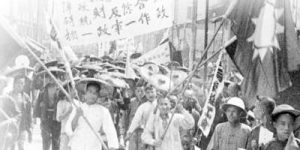Full review at SFU Chinese History.
In 2009, Haymarket Books made available the text of the original edition of The Tragedy of the Chinese Revolution, first published in 1938. Isaacs does not conceal his partisanship or purpose. His investigations into the causes of the defeat of the Communists in 1927 led him to break with the Stalinists and join the Left Opposition led by Leon Trotsky. He intended to demonstrate how the “whole weight and authority of the October revolution and the Communist International were thrown not behind the proletariat as an independent force, but behind the national bourgeoisie. As a result of this the masses were halted at the height of their forward surge, their organizations were shattered, their leaders decapitated…. This was the tragedy of the Chinese revolution” (39). By subordinating the workers’ movement to the KMT, which then suppressed it, and then by fleeing to the countryside and abandoning the workers, “the Communists succeeded only in divorcing themselves completely from the class they claimed to represent” (289). Isaacs argues, “The Communist Party tried to substitute itself for the proletariat as a class. In the process, however, it was transformed into a peasant party” (301). By 1951, Isaacs no longer identified with Trotskyism, and in the climate of McCarthyism, he heavily revised his work. He removed Trotsky’s introduction as well as the many instances in which Isaacs suggested what a genuinely revolutionary communist party would have done. Haymarket’s re-publication of the original edition could be seen as a rejection of the Cold War revisions and a reclamation of Isaacs’ original theoretical framework and many of the political conclusions drawn therefrom.
Book Review: Harold Isaacs, The Tragedy of the Chinese Revolution, 2009 [1938].

Book Review of Harold Isaacs. The Tragedy of the Chinese Revolution. Chicago: Haymarket Books, 2009 [1938]. Full review at SFU Chinese History (see link in description)